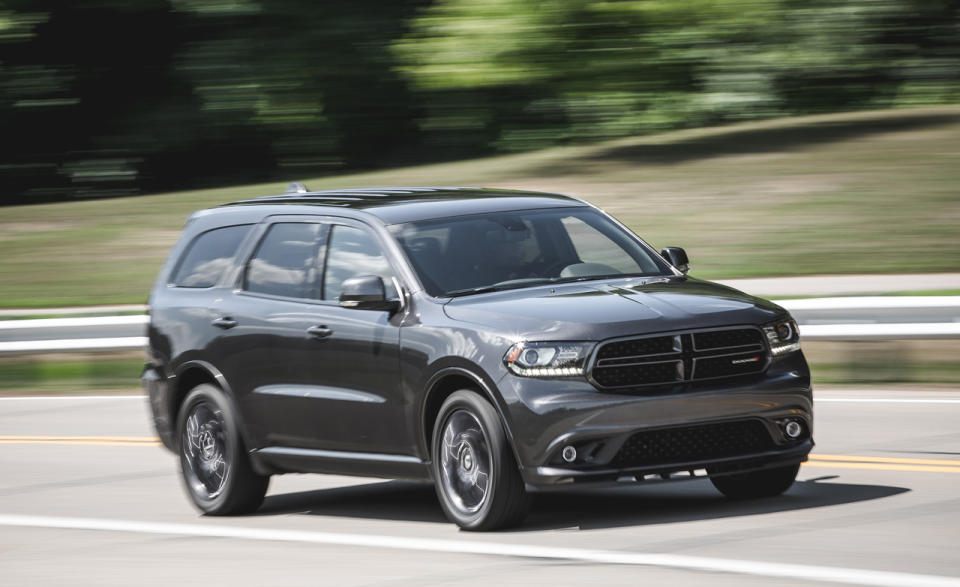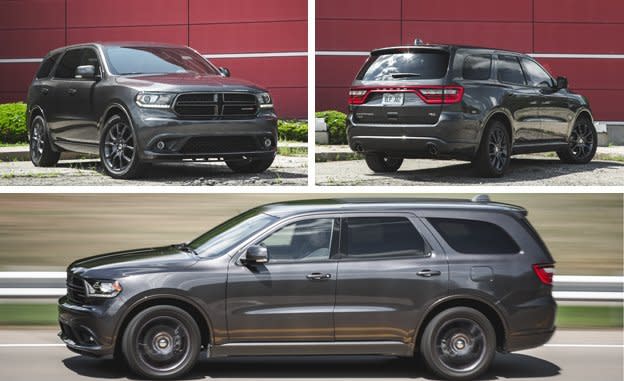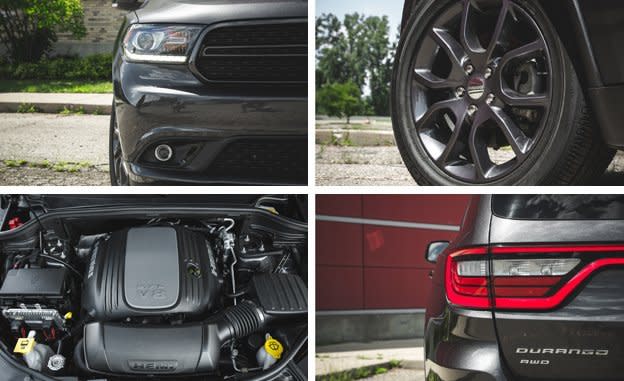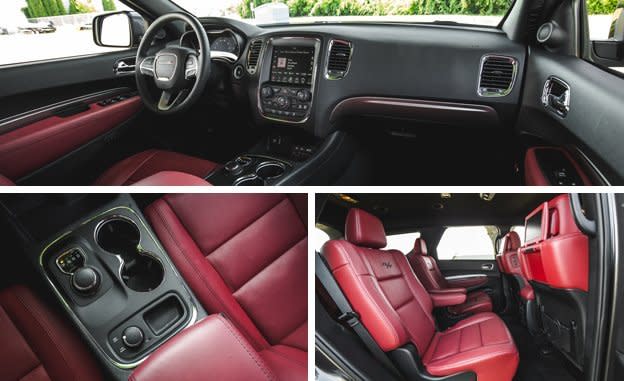2016 Dodge Durango V-8 AWD

The Dodge Durango is the longer-wheelbase, slightly racier sibling to Jeep’s better-known Grand Cherokee. Named after a Colorado town boasting fewer than 17,000 residents and its own narrow-gauge railroad, the Durango has an interesting lineage. Like the 2011–2017 Grand Cherokee, the current generation was designed and developed in the era of DaimlerChrysler, the car-company marriage made in hell. While most three-row SUVs ride on stout body-on-frame foundations, this is a theoretically lighter and more space-efficient unibody design assembled in the Motor City. Like most things, weight is relative: The specimen reviewed here, a Durango R/T, registered a hefty 5369 pounds on our scales.
So far, FCA hasn’t seen fit to fit the Durango with the 475-hp 6.4-liter V-8 that powers the Jeep Grand Cherokee SRT, though rumors of a pending Durango SRT persist. For now, at least, its maker proudly postures the Durango as the Dodge Charger of the SUV segment, and the R/T edition is as racy as this model line gets with a 5.7-liter Hemi V-8 in place of the standard, 295-hp 3.6-liter V-6, in combination with a ZF-designed eight-speed Torqueflite automatic transmission. The venerable Hemi appellation describes a Mexico-made 360-hp V-8 with a mix of rustic and recent technologies. The deep-skirt block is cast iron. Aluminum cylinder heads (lacking any hint of hemisphere in their combustion chambers) support a pushrod valvetrain blessed with variable valve timing, port fuel injection, and cylinder deactivation during light-load cruising to maximize EPA-rated mpg.

The R/T AWD version reviewed here leaves the starting gate with a premium $45,490 price tag in large part because it’s lavishly equipped with heated (first two rows) and ventilated (front only) leather seats, three seating rows for six occupants, a two-speed transfer case, three-zone automatic climate control, premium audio with an 8.4-inch touchscreen and wheel-spoke controls, and a slew of power outlets. Supporting the Racy/Trendy label, there are paddle shifters, a sport suspension with a ride height dropped by nearly an inch, 20-inch aluminum wheels fitted with 265/50R-20 low-rolling-resistance all-season radials, and dual exhaust tips. Two options raised this test vehicle’s bottom line to $48,480: a $1995 twin-screen rear entertainment system and $995 for second-row fold-and-tumble captain’s chairs.
Over the years, American families have systematically swapped their minivans for three-row SUVS like this one, surrendering convenient sliding-door access for a more assertive posture. The dozen or so mid-size triple-row utilities on the market with a base price below $40,000 all offer excellent versatility with seating readily convertible to cargo space. The Durango R/T’s added attraction is a sporty exterior with actual fun-to-drive temperament baked into its soul.

Lots of “Go,” Not So Much “Stop”
This Durango earned a B+ at the test track by hustling to 60 mph in a fleet 6.2 seconds and through the quarter-mile in 14.7 seconds at 95 mph. It’s quick on its feet during passing and will top out at 120 mph if you need to beat a narrow-gauge tourist train over a Colorado crossing. While the Hemi V-8 is outspoken above 4000 rpm to the tune of 80 decibels during flat-out acceleration, it fades mostly into the background during cruising, although the exhaust note goes grumbly when the Hemi switches into four-cylinder mode, something that can be diminished by toggling off the switch for Eco mode. We measured 0.78 g of lateral grip on the skidpad, not bad for such a large, husky truck rolling on all-season Bridgestone Ecopia tires. The Durango’s one low grade came during emergency braking tests. As the arresting gear warmed during successive brake applications, the 70-to-zero-mph stopping distance grew from the initial not-very-good 193 feet to a more concerning 207 feet (fifth stop). So when you hitch a trailer (the Durango’s tow limit is a substantial 7400 pounds), make sure it is equipped with its own brakes.
One worthwhile new-for-2016 feature is a Sport mode button mounted just above the console to delay upshifts, increase steering effort, and sharpen throttle response. Once you click a steering-wheel-mounted paddle, this eight-speed automatic holds the selected gear even at the 5900-rpm redline. Accompanying each upshift, a ripping noise rattles through the dual exhaust pipes. While rotary shift knobs are not our preference, this arrangement does leave more room for cupholders.
Attacking our favorite back road with gusto, we observed astute body control and resistance to excessive lean in corners, combined with a placid ride. The front and rear suspensions are both independent designs with rubber-isolated subframes to filter road and driveline buzz from the cabin, although we noted substantial noise from the rear end making its way into the cabin over rough roads. Sport-mode steering effort and response are both good, though there’s virtually no feedback from the pavement to the rim of the leather-wrapped wheel. While we’d prefer less dive during aggressive braking, considering the size and weight of this Durango, it’s surprisingly competent when thrashed over twisty, undulating byways.

Flexible Utility
To invite all aboard the Durango, its back doors are long, and the middle-row seats—captain’s chairs in our case—fold and tumble forward with a single yank of a fabric loop. The headrests also drop out of the way during this cabin reconfiguration. The rear seats are habitable by adults and should prompt minimal whining. Kids will love it back there, in part because they can stretch their legs atop folded middle seats while watching the 9.0-inch Blu-ray DVD video screens attached to the front seatbacks, although this lounge posture is discouraged by a warning label for safety reasons. Four overhead and two console vents provide airflow and are adjustable for temperature and volume. Folding all seatbacks creates a load floor that could theoretically sleep two six-footers as long as interseat gaps are spanned with a rigid panel. While there’s insufficient space to tote four-by-eight-foot materials, the 17-cubic-foot hold behind the third row stretches incrementally to 47 and 85 cubic feet when the third-row and then the second-row seats are sacrificed. There’s also a small but handy cubby under the rear floor, and the hatch opens and closes with taps of the key fob. This R/T’s front seats drew a couple of gripes from drivers who found thigh support lacking and the lumbar bulge out of place.
The reconfigurable 7.0-inch electronic cluster behind the steering wheel and the 8.4-inch dashboard touchscreen offer a wealth of info, entertainment, and control functions. Dodge’s Uconnect Access provides voice command of climate, audio, texting, and Bluetooth connections. A Yelp search function can locate destinations and determine routes for display on 3D maps. Various media apps are available, but neither Apple CarPlay nor Android Auto connects here.
Kudos to Dodge for keeping this relatively rustic platform current with excellent chassis tuning, entertaining creature comforts, and commendable versatility. The 16 mpg we observed is tolerable as long as regular gas stays cheap. Considering all that the Durango R/T accomplishes with a smile, it’s a sensible choice for today’s families.
Specifications >
VEHICLE TYPE: front-engine, rear-/4-wheel-drive, 6-passenger, 4-door hatchback
PRICE AS TESTED: $48,480 (base price: $45,490)
ENGINE TYPE: pushrod 16-valve V-8, iron block and aluminum heads, port fuel injection
Displacement: 345 cu in, 5654 cc
Power: 360 hp @ 5150 rpm
Torque: 390 lb-ft @ 4250 rpm
TRANSMISSION: 8-speed automatic with manual shifting mode
DIMENSIONS:
Wheelbase: 119.8 in
Length: 201.2 in
Width: 75.8 in Height: 71.9 in
Passenger volume: 141 cu ft
Cargo volume: 17 cu ft
Curb weight: 5369 lb
C/D TEST RESULTS:
Zero to 60 mph: 6.2 sec
Zero to 100 mph: 16.3 sec
Zero to 110 mph: 20.6 sec
Rolling start, 5–60 mph: 6.6 sec
Top gear, 30–50 mph: 3.0 sec
Top gear, 50–70 mph: 4.1 sec
Standing ¼-mile: 14.7 sec @ 95 mph
Top speed (governor limited): 120 mph
Braking, 70–0 mph: 193 ft
Roadholding, 300-ft-dia skidpad: 0.78 g
FUEL ECONOMY:
EPA city/highway driving: 14/22 mpg
C/D observed: 16 mpg
C/D observed highway driving: 23 mpg
C/D observed highway range: 560 mi

 Yahoo Autos
Yahoo Autos 